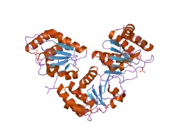| DUSP5 | |||||||||||||||||||||||||||||||||||||||||||||||||||
|---|---|---|---|---|---|---|---|---|---|---|---|---|---|---|---|---|---|---|---|---|---|---|---|---|---|---|---|---|---|---|---|---|---|---|---|---|---|---|---|---|---|---|---|---|---|---|---|---|---|---|---|
 | |||||||||||||||||||||||||||||||||||||||||||||||||||
| |||||||||||||||||||||||||||||||||||||||||||||||||||
| Identifiers | |||||||||||||||||||||||||||||||||||||||||||||||||||
| Aliases | DUSP5, DUSP, HVH3, dual specificity phosphatase 5 | ||||||||||||||||||||||||||||||||||||||||||||||||||
| External IDs | OMIM: 603069 MGI: 2685183 HomoloGene: 3256 GeneCards: DUSP5 | ||||||||||||||||||||||||||||||||||||||||||||||||||
| |||||||||||||||||||||||||||||||||||||||||||||||||||
| |||||||||||||||||||||||||||||||||||||||||||||||||||
| |||||||||||||||||||||||||||||||||||||||||||||||||||
| |||||||||||||||||||||||||||||||||||||||||||||||||||
| |||||||||||||||||||||||||||||||||||||||||||||||||||
| Wikidata | |||||||||||||||||||||||||||||||||||||||||||||||||||
| |||||||||||||||||||||||||||||||||||||||||||||||||||
Dual specificity protein phosphatase 5 is an enzyme that in humans is encoded by the DUSP5 gene.[5][6]
Function
The protein encoded by this gene is a member of the dual specificity protein phosphatase subfamily. These phosphatases inactivate their target kinases by dephosphorylating both the phosphoserine/threonine and phosphotyrosine residues. They negatively regulate members of the mitogen-activated protein (MAP) kinase superfamily (MAPK/ERK, SAPK/JNK, p38), which are associated with cellular proliferation and differentiation. Different members of the family of dual specificity phosphatases show distinct substrate specificities for various MAP kinases, different tissue distribution and subcellular localization, and different modes of inducibility of their expression by extracellular stimuli. This gene product inactivates ERK1/2, is expressed in a variety of tissues with the highest levels in pancreas and brain, and is localized in the nucleus.[6]
References
- 1 2 3 GRCh38: Ensembl release 89: ENSG00000138166 - Ensembl, May 2017
- 1 2 3 GRCm38: Ensembl release 89: ENSMUSG00000034765 - Ensembl, May 2017
- ↑ "Human PubMed Reference:". National Center for Biotechnology Information, U.S. National Library of Medicine.
- ↑ "Mouse PubMed Reference:". National Center for Biotechnology Information, U.S. National Library of Medicine.
- ↑ Martell KJ, Kwak S, Hakes DJ, Dixon JE, Trent JM (Jul 1994). "Chromosomal localization of four human VH1-like protein-tyrosine phosphatases". Genomics. 22 (2): 462–4. doi:10.1006/geno.1994.1411. hdl:2027.42/31442. PMID 7806236.
- 1 2 "Entrez Gene: DUSP5 dual specificity phosphatase 5".
Further reading
- Robertson NG, Khetarpal U, Gutiérrez-Espeleta GA, Bieber FR, Morton CC (Sep 1994). "Isolation of novel and known genes from a human fetal cochlear cDNA library using subtractive hybridization and differential screening". Genomics. 23 (1): 42–50. doi:10.1006/geno.1994.1457. PMID 7829101.
- Kwak SP, Dixon JE (Jan 1995). "Multiple dual specificity protein tyrosine phosphatases are expressed and regulated differentially in liver cell lines". The Journal of Biological Chemistry. 270 (3): 1156–60. doi:10.1074/jbc.270.3.1156. PMID 7836374.
- Ishibashi T, Bottaro DP, Michieli P, Kelley CA, Aaronson SA (Nov 1994). "A novel dual specificity phosphatase induced by serum stimulation and heat shock". The Journal of Biological Chemistry. 269 (47): 29897–902. doi:10.1016/S0021-9258(18)43965-8. PMID 7961985.
- Ueda K, Arakawa H, Nakamura Y (Aug 2003). "Dual-specificity phosphatase 5 (DUSP5) as a direct transcriptional target of tumor suppressor p53". Oncogene. 22 (36): 5586–91. doi:10.1038/sj.onc.1206845. PMID 12944906.
- Mandl M, Slack DN, Keyse SM (Mar 2005). "Specific inactivation and nuclear anchoring of extracellular signal-regulated kinase 2 by the inducible dual-specificity protein phosphatase DUSP5". Molecular and Cellular Biology. 25 (5): 1830–45. doi:10.1128/MCB.25.5.1830-1845.2005. PMC 549372. PMID 15713638.
- Jeong DG, Cho YH, Yoon TS, Kim JH, Ryu SE, Kim SJ (Jan 2007). "Crystal structure of the catalytic domain of human DUSP5, a dual specificity MAP kinase protein phosphatase". Proteins. 66 (1): 253–8. doi:10.1002/prot.21224. PMID 17078075. S2CID 30285092.
- Sarközi R, Miller B, Pollack V, Feifel E, Mayer G, Sorokin A, Schramek H (Apr 2007). "ERK1/2-driven and MKP-mediated inhibition of EGF-induced ERK5 signaling in human proximal tubular cells". Journal of Cellular Physiology. 211 (1): 88–100. doi:10.1002/jcp.20909. PMID 17131384. S2CID 39397816.
External links
- Overview of all the structural information available in the PDB for UniProt: Q16690 (Dual specificity protein phosphatase 5) at the PDBe-KB.





